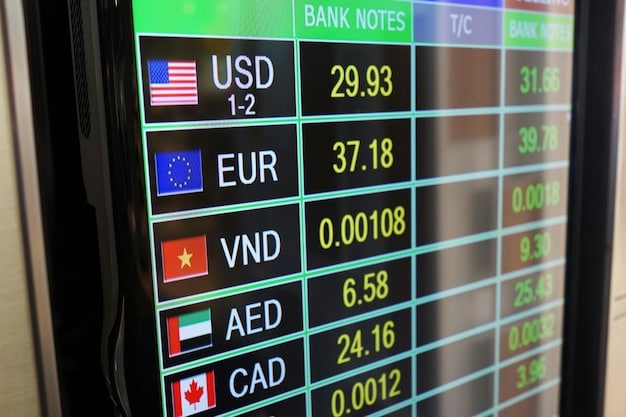Maximize Your Yen: Top Exchange Rate Tips for US Tourists in Japan

Maximize Your Yen: Insider Strategies for US Tourists to Get the Best Exchange Rates in Japan This Season involves understanding the nuances of currency exchange, timing your transactions wisely, leveraging credit cards with favorable terms, and exploring alternative exchange methods like ATMs and digital platforms to enhance your spending power while traveling in Japan.
Planning a trip to Japan from the US? One of the most crucial aspects of your preparation should be figuring out how to Maximize Your Yen: Insider Strategies for US Tourists to Get the Best Exchange Rates in Japan This Season. Securing the best possible exchange rate can significantly impact your travel budget, allowing you to experience more of what Japan has to offer. Let’s explore strategies to make your dollar go further.
Understanding the Yen Exchange Rate
The yen exchange rate is dynamic and can fluctuate based on various factors including economic conditions, geopolitical events, and market speculation. For US tourists, understanding these fluctuations is key to timing currency exchanges effectively.
Factors Influencing Exchange Rates
Several elements play a role in the exchange rate between the US dollar and the Japanese yen. Keeping an eye on these indicators can provide insights into potential rate movements.
- Interest Rates: Differences in interest rates set by the Federal Reserve in the US and the Bank of Japan can significantly impact currency values.
- Economic Health: Relative economic performance, including GDP growth, unemployment rates, and trade balances, affects investor confidence and currency demand.
- Geopolitical Stability: Global events and political stability in both countries can lead to currency fluctuations.
- Market Sentiment: Speculation and investor sentiment can cause abrupt changes in exchange rates, independent of underlying economic factors.
By monitoring these factors, you can get a sense of whether the yen is likely to strengthen or weaken against the dollar, informing your decisions on when and how to exchange your money.
In conclusion, knowledge about these factors can empower US tourists to make informed decisions about currency exchange, potentially saving money and enhancing their travel budget.
Best Places to Exchange Currency in the US
Exchanging currency before you leave the US offers convenience, but where you choose to do it can drastically affect the exchange rate you receive. It’s essential to weigh your options to find the most cost-effective solution.
Banks and Credit Unions
Your local bank or credit union can be a reliable place to exchange dollars for yen. They typically offer competitive rates to account holders, although it’s wise to compare their rates with other options.
Currency Exchange Services
Companies like Travelex and Currency Exchange International (CXI) specialize in foreign currency exchange. While convenient, their rates may include higher fees, so it’s prudent to compare their offerings with those of banks and credit unions.
When evaluating these providers, consider convenience, exchange rates, and any associated fees. Choosing wisely can result in significant savings, giving you more to spend on your Japanese adventure.

Ultimately, doing your research and comparing rates is critical to ensuring you get the most favorable exchange before even stepping foot on your flight to Japan.
Leveraging Credit Cards and ATMs in Japan
Using credit cards and ATMs while in Japan can be a convenient way to manage your finances, but it’s essential to understand the associated fees and strategies for minimizing them.
Choosing the Right Credit Card
Select a credit card with no foreign transaction fees to avoid extra charges on every purchase. Many travel-focused cards offer this benefit, along with points or miles that can be redeemed for future travel.
Using ATMs for Cash Withdrawals
Japanese ATMs, particularly those at 7-Eleven stores and post offices, are generally accessible to foreign cards. Be aware of withdrawal fees and potential conversion charges from your bank. Withdrawing larger sums less frequently can help reduce these fees.
- Check for Fees: Before withdrawing cash, understand the fees your bank charges for international ATM use.
- Use ATMs Wisely: Opt for ATMs that are known to accept foreign cards, like those at 7-Eleven or Japan Post Bank locations.
- Minimize Transactions: Withdraw larger amounts to reduce the frequency of transaction fees.
Careful planning and awareness will help you utilize credit cards and ATMs effectively, reducing unnecessary expenses and keeping more money in your pocket for exploring Japan.
In conclusion, by selecting the right financial tools and being mindful of fees, you can enhance your financial efficiency while traveling in Japan.
Digital Currency Platforms for Travelers
Modern travelers have an array of digital platforms to manage their currency exchange both before and during their voyages. These platforms offer convenience, flexibility, and often competitive exchange rates.
Online Currency Exchange Services
Services like Wise (formerly TransferWise) and Revolut offer currency exchange at rates close to the mid-market rate, often with lower fees than traditional banks. These platforms allow you to exchange currency online and hold balances in multiple currencies.
Mobile Payment Apps
Apps like PayPal and Venmo can be used for international transactions, but it’s essential to be aware of their exchange rates and fees, which can sometimes be higher than specialized currency exchange services.

Choosing the right digital platform depends on your specific needs and usage patterns. Comparing fees, exchange rates, and convenience factors will help you make a decision that fits your travel style and financial goals.
To summarize, digital currency platforms provide a valuable alternative to traditional methods, offering ease and often better rates for currency exchange when traveling.
Timing Your Currency Exchange
The timing of your currency exchange can significantly influence the rate you receive. Monitoring market trends and being strategic about when you convert your dollars into yen can yield better results.
Watching Market Trends
Keep an eye on currency market trends through financial news websites and apps. Understanding potential fluctuations can help you predict favorable times to exchange currency.
Avoiding Airport Exchanges
Airport currency exchange kiosks typically offer the worst exchange rates due to high overhead and captive customers. It’s best to avoid these options unless absolutely necessary.
- Follow Financial News: Stay informed about economic events that may impact exchange rates.
- Use Rate Alerts: Set up alerts on currency exchange apps to notify you of favorable rates.
- Avoid Peak Travel Times: Exchange currency before the rush, as rates might worsen closer to peak travel seasons.
By being proactive and timing your currency exchange strategically, you can optimize your exchange rate and increase your travel budget.
In conclusion, timing and awareness are crucial elements in securing the most advantageous yen exchange rate for your trip to Japan.
Budgeting and Tracking Expenses in Japan
Effective budgeting and diligent expense tracking can enhance your financial control during your trip to Japan, helping you stay within your means and maximize your experiences.
Creating a Realistic Budget
Research average costs for accommodation, meals, transportation, and activities in Japan. Establish a daily or weekly budget that reflects your spending habits and financial constraints.
Using Budgeting Apps
Utilize budgeting apps like Mint, YNAB (You Need a Budget), or personal finance apps with expense tracking features to monitor your spending in real-time.
Ultimately, disciplined budgeting and attentive expense tracking can help you manage your finances effectively, ensuring a more enjoyable and stress-free journey in Japan.
To sum up, these tools provide valuable insights into your spending habits, helping you make informed decisions and stay within your budget, maximizing your overall travel experience.
| Key Point | Brief Description |
|---|---|
| 🏦 Banks & Credit Unions | Often offer competitive rates for account holders. |
| 💳 Credit Cards | Choose cards with no foreign transaction fees for purchases. |
| 🏧 ATMs in Japan | Use 7-Eleven and post office ATMs; minimize withdrawals. |
| 📱 Digital Platforms | Consider Wise or Revolut for competitive rates. |
Frequently Asked Questions
▼
Research and compare rates at your bank, credit union, and online currency exchange services. Avoid airport kiosks, which typically offer less favorable rates.
▼
While acceptance is growing, especially in larger cities, it’s beneficial to carry some cash for smaller establishments and rural areas that may not accept credit cards.
▼
Yes, but focus on ATMs in 7-Eleven stores and post offices. Be aware of withdrawal fees from your bank and the ATM operator, and consider withdrawing larger amounts.
▼
Use credit cards that do not charge foreign transaction fees. When using ATMs, minimize the number of withdrawals and be aware of your bank’s fees for international transactions.
▼
It is advisable to exchange a small portion for immediate needs, but avoid exchanging large sums. Use ATMs or credit cards strategically to manage expenses during your trip.
Conclusion
By adopting these insider strategies, US tourists can significantly maximize your yen and enhance their travel experience in Japan. Knowledge of exchange rates, strategic use of credit cards and ATMs, and smart budgeting will all contribute to a more cost-effective and enjoyable trip.





